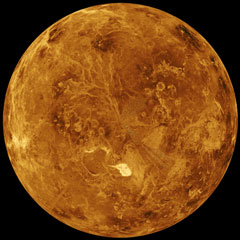This picture shows the northern hemisphere of Venus. It was made using radar. It shows how the surface of Venus might look if we could see through the thick atmosphere. The North Pole is at the center of the picture. The bright area below the center is Maxwell Montes, the highest mountain chain on Venus.
Click on image for full size
Image courtesy of NASA/JPL.
The Poles of Venus
Venus is the hottest planet in our Solar System. On Earth, places near the equator are much warmer than places near the poles. On Venus, it is really hot everywhere... even at the North and South Poles.
Venus doesn't have any oceans. It does have two large areas of higher ground. Scientists call the raised areas "continents". One continent is near the North Pole. It is called Ishtar Terra and is about as big as Australia. The highest mountain range on Venus is on Ishtar Terra. The mountains are called Maxwell Montes. They are about 11 km (6.6 miles) high, a little bit taller than Mount Everest on Earth.
The land is rugged around the poles of Venus. There are groups of ridges near each pole. These ridges rise a few kilometers above the lower plains. They are up to hundreds of kilometers wide and thousands of kilometers long. One group of ridges is in Lavinia Planitia near the South Pole. Another set of ridges is next to Atalanta Planitia near the North Pole.
Venus isn't tilted on its axis very much. Earth is tilted about 23°. Venus is only tilted 3°. That means there are no seasons on Venus. It is pretty much the same temperature all year round on Venus... hot!
The atmosphere above the poles of Venus is strange. A "vortex" (plural: vortices) is a swirling mass of air and clouds... like a tornado or a hurricane. There are two vortices in the atmosphere above each of the poles of Venus!
You might also be interested in:

How did life evolve on Earth? The answer to this question can help us understand our past and prepare for our future. Although evolution provides credible and reliable answers, polls show that many people turn away from science, seeking other explanations with which they are more comfortable.
...more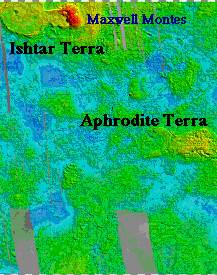
Ishtar Terra is one of the Plateau Highlands of Venus, is found near the north pole, and is about the size of the continental United States. Ishtar Terra contains the four main mountain ranges of Venus
...more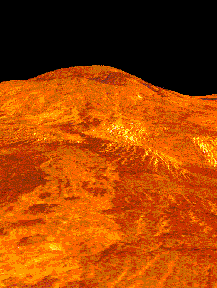
The four main mountain ranges of Venus are named Maxwell Montes, Frejya Montes, Akna Montes, and Danu Montes. These are found on Ishtar Terra. Mountain ranges are formed by the folding and buckling of
...more
The Earth is rotating around an axis (called its rotational axis). Some objects rotate about a horizontal axis, like a rolling log. Some objects, such as a skater, rotate about a vertical axis. The Earth's
...more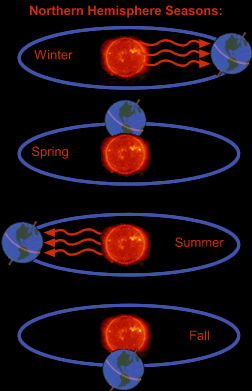
During the year, the seasons change depending on the amount of sunlight reaching the Earth as it revolves around the Sun. The seasons are caused as the Earth, tilted on its axis, travels in a loop around
...more
Tornadoes form from severe thunderstorms. They have a very high energy density which means that they affect a small area but are very destructive to that area. They also don't last very long which makes
...more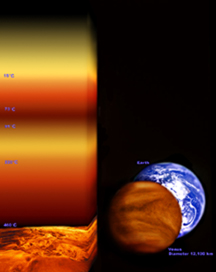
The atmosphere of Venus is very hot and thick. You would not survive a visit to the surface of the planet - you couldn't breathe the air, you would be crushed on by the enormous weight of the atmosphere,
...more
This is a map of the surface of Venus (turned sideways!). As can be seen on the map, the surface of Venus consists of 2 large continents with mountain ranges, and a few large islands. There are many craters,
...more


